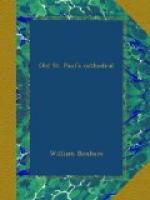“September 7th.—I went this morning on foote from White-hall as far as London Bridge, thro’ the late Fleete-streete, Ludgate Hill, by St. Paules, Cheapeside, Exchange, Bishopsgate, Aldersgate, and on to Moorefields, thence thro’ Cornehill, &c., with extraordinary difficulty, clambering over heaps of yet smoking rubbish, and frequently mistaking where I was....
“At my returne I was infinitely concern’d to find that goodly Church St. Paules now a sad ruine, and that beautifull portico (for structure comparable to any in Europe, as not long before repair’d by the late King) now rent in pieces, flakes of vast stone split asunder, and nothing now remaining intire but the inscription in the architrave, shewing by whom it was built, which had not one letter of it defac’d. It was astonishing to see what immense stones the heate had in a manner calcin’d, so that all the ornaments, columns, freezes, capitals, and projectures of massie Portland-stone flew off, even to the very roofe, where a sheet of lead covering a great space (no less than six akers by measure) was totally mealted; the ruines of the vaulted roofe falling broke into St. Faith’s, which being fill’d with the magazines of bookes belonging to the Stationers, and carried thither for safety, they were all consum’d, burning for a weeke following. It is also observable that the lead over the altar at the East end was untouch’d, and among the divers monuments, the body of one Bishop remain’d intire. Thus lay in ashes that most venerable Church, one of the most antient pieces of early piety in the Christian world.”
Sancroft, who was Dean at the time of the fire, and who afterwards became Archbishop, was anxious to restore the cathedral on the old lines. Henchman was Bishop, but he left the matter for the Dean to deal with, though he not only rebuilt the Bishop’s Palace at his own expense but contributed munificently to the new building. Sancroft preached within the ruined building before the King on October 10th, 1667, from the text, “His compassions fail not,” and the sermon is really eloquent. The congregation was gathered at the west end, which had been hastily fitted up. The east end was absolute ruin.




